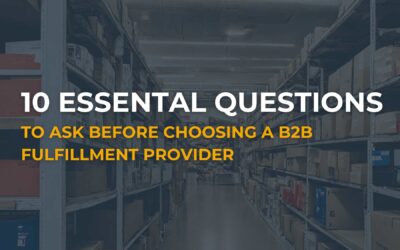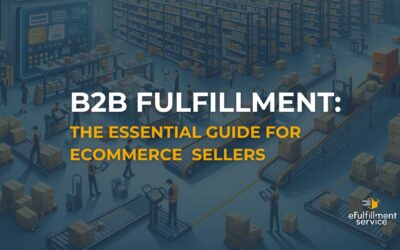
Looking over the ecommerce statistics from 2020, eFulfillment Service shares advice for ecommerce merchants in 2021 and longer term, including specific intel for small businesses and startups. The ecommerce industry is just now starting to see beyond the online order volume created by the coronavirus, to the more subtle impact on ecommerce.
A closer look at 2020 reveals, “This is a very complicated case … You know, a lotta ins, lotta outs, lotta what-have-you’s,” as the Dude in the Big Lebowski says.
While 2020 was an overwhelming success for the ecommerce industry, some smaller online sellers may have seen challenges, as outlined in the background discussions below. eFulfillment Service used 2020 trends as the foundation for developing ecommerce strategies for sellers in 2021.
5 Strategies for Online Sellers to Apply in 2021
Ultimately these strategies help sellers of all sizes answer the question, how can we gain more control over our online retail business, when the world spins out of control.
1. Cultivate Your Customer Relationships
The larger the online marketplace like Etsy, Amazon and eBay, the more distance between you and the shopper. And the algorithms are designed to sell you the marketing tools, sponsored opportunities and pay-to-play options. To paraphrase Seth Godin’s advice from a recent keynote, build a great product and then nurture the fans you have. Not only should you have a way for your fans to buy directly from you, but you should also have a robust ongoing communications program engaging them directly and often. (Here’s more on Seth Godin’s advice)
2. Diversify Manufacturing Sources, Look for Near-Sourcing
The longer your supply chain is, the more places for disruption. If you can’t near-shore your manufacturing and shorten the time it takes to get to your fulfillment center, then prepare to overlap your inventory so you don’t run out. Keep a diverse set of manufacturing options. No one sells from an empty shelf.
3. Take Advantage of Longer Delivery Trends
Pre-pandemic, Amazon Prime and Walmart memberships drove consumers to expect online orders to arrive in 2 days. Fulfillment industry conversations were anticipating a market shift to one-day and same day preferences. The last year has eased consumer focus on fast turn-around—being able to order toilet paper and disinfectant wipes at all was celebrated at points. During the holidays, consumers recognized the need to make online gift purchases earlier, sometimes waiting for weeks. As turn-around time expectations have eased, smaller sellers, those with very light items or those with a lot of SKUs, may benefit from consolidating inventory in fewer or one location. Post-pandemic, and as long as the trend lasts, splitting inventory doesn’t always make sense.
4. Set The Right Delivery Expectation
What consumers have come to demand is clear communication of delivery timelines before the online sale, and easy ways to track delivery status after checkout. Whether consumers are buying a one-of-a-kind handmade pair of mittens, or the latest nutraceutical blend, they want to be able to watch the package move towards its final destination. And that means your fulfillment software, shipping carriers and consumer communications have to work seamlessly—work with fulfillment pros to get that right.
5. Secure Direct-to-Consumer Fulfillment Partners Outside of Marketplaces
If there’s one lesson to take away from 2020, it’s that nimble partners allow you to change with the marketplace. Secure a professional fulfillment partner, one that can adapt between fulfilling online orders from your website shopping cart, like Shopify, WooCommerce, Magento or 3dcart, and then ship internet orders from Walmart.com customers. And finally, a professional logistics warehouse that can prep inventory to go to Amazon.
As Walter says,”There are rules.”
Even as the ecommerce industry grows, internet merchants that don’t have strong partnerships and multiple options all along the supply chain are facing split pins at the end of a bowling alley. Following are the ecommerce marketplace factors from 2020 that support the retailing strategies above.
Background—Which Online Merchants Were Successful in 2020?
Ecommerce stats show June 2020 sales were up 104% over the previous year, according to a round up by Digital Third Coast. Ecommerce industry experts report the growth spurt was anywhere from four years to a decade’s worth in one year.
Big Marketplaces Enjoyed Big Successes
Both Walmart.com and Amazon reported membership growth in 2020, with Walmart netting 11% of the market and 45% of those polled reported that they kept their Amazon Prime membership after joining Walmart, according to Digital Commerce 360. Amazon added 14 million Prime members last year, the highest growth rate in 4 years. Nimble big box stores that added curbside pick-up, improved buy-online-pick-up-in-store (BOPIS) and direct to consumer services were also able to capitalize on the shifts caused by the pandemic.
What online product sales categories trends grew faster than others? Zentail reports that outside of the obvious personal protection equipment or PPE, of masks, face shields, disinfectants and health care supplies, there were categories of online sales that did better than others. As the spring and summer progressed, outdoors equipment and camping gear online sales increased with gardening, outdoor home decor and equipment, hunting products and purchases for pets. As fall approached, luxury goods, educational toys, high-end make up and items to make our homes more comfortable.
At eFulfillment Service, we saw overall online order growth of 40% in 2020, as compared to 2019. Our receiving department saw increases of roughly 50% as well. While our staffing increased to meet the new volume demands, we were also able to improve our order processing speed by 13% and saw efficiencies in returns and assembly teams, too.
eFulfillment Service Clients Grow, Pivot & Thrive
Both our Client Care and Customer Service teams ramped up to handle the increased communications with clients. We posted daily updates of workload status, sent email communications to our entire client list several times a month and answered thousands of client questions. Throughout 2020, our teams maintained a 98% client satisfaction rating.
One of the most important services eFulfillment Service offered clients in 2020 was the ability to pivot from FBA prep services, replenishing inventory at Amazon, to serving as our client’s Fulfillment By Merchant (FBM) provider. Because we already had their products loaded in our system and integrated fully with Amazon we could give them immediate answers, and service.
Small Businesses and Start-ups Faced Challenges in 2020
Not all the 2020 ecommerce news was shiny and bright. Many smaller sellers saw a decline in spring sales in 2020. Those sellers that depended heavily on Fulfillment By Amazon (FBA), but weren’t an essential product, were forced to the back of Amazon’s order processing line. With non-essential items showing FBA delivery timelines of two weeks, three weeks or even longer, Prime members were abandoning carts and looking for faster sources. And those non-essential online sellers scrambled to set up parallel fulfillment partnerships, switching their Amazon seller accounts from FBA to Fulfillment by Merchant (FBM) in order to overcome delays and capitalize on opportunities.
eFulfillment Service clients overall enjoyed increased online sales in 2020. Big sellers got bigger and smaller companies and start-ups plateaued. Not only were some of these smaller, non-essential brands forced to the back of Amazon’s order processing service, but they also struggled for visibility on bigger marketplaces, like Amazon and Walmart.com during the holidays
Ecommerce Definition: Black Friday: Traditionally, the Friday after Thanksgiving was the bricks-and-mortar retail start to the holiday gift giving season. The date was nicknamed Black Friday because it was the first date where a retail store was profitable, moving from the “red” or non-profitable to the “black” or profitable area of an accounting ledger. With the advent of online sales, the Monday after Thanksgiving saw a boost in online sales. Early in online selling, Cyber Monday’s boost may have been supported by consumers shopping at work after the holiday on vacation, where they had better internet services.
Forbes reports Adobe Analytics figures showing that Black Friday online sales for 80 of the top 100 internet retailers had an overall increase of 21%, with sales of $9 billion. And similarly Cyber Monday’s online sales grew 15.1% to $10.8 billion. Amazon gave a nod to smaller sellers with promotions and campaigns focused on a select few artisans, but made no discernible changes to the Amazon algorithm benefiting small volume sellers.
Many smaller online merchants had to take attention off marketing actions and put it on direct to consumer fulfillment—they had to find a third party logistics company (3PL) to provide FBM services. If they had a distribution center already, they may have had to find another provider, as successful 3PLs raised performance standards like invoice minimums and monthly order minimums to favor larger, more profitable online sellers.
Ecommerce Definition: Cyber Week or The Turkey Five: Cyber Week is defined as the five days from Thanksgiving Day through the following Monday. Also known as the Turkey Five, these days are typically the start of the gift shopping season. As online sales have evolved, these 5 days of high-volume online orders are characterized by online retailers’ goal to secure a large portion of holiday gift giving budgets early, using promotions and sales to attract attention and encourage purchases.
Background—Ecommerce Industry Challenges of 2020
The influence of pandemic is of course the primary mover in the ecommerce business for 2020 and we all know that Amazon enjoyed the biggest successes, pressures and news coverage. For the rest of online sellers, 2020 was mixed:
1. Shipping Carrier Delays: With the pandemic starting in China, manufacturer and shipping delays began at the source. Those that had diversified manufacturing during U.S. tariffs against China were able to produce product, but still saw shipping delays as issues cascaded across the global supply chain lines. Global shipping remains overloaded with a backlog of products stacked on docks, waiting to be shipped, move through customs, travel to fulfillment centers and finally be received into inventory.
2. Rising Cargo Shipping Rates: Container shortages, reduced shipping capacity and growing online sales volume allowed shipping carriers to charge higher prices, adding surcharges and seasonal rate increases.
3. Fulfillment Labor Famine: Despite soaring unemployment, shipping carriers and fulfillment centers found it difficult to hire enough employees to manage the high online order volume that became—the new normal. The holiday season increased the pressure further, and only the most savvy recruiters were able to staff up to manage holiday struggles.
4. Reliable Manufacturing Sources: Some U.S. sellers may have been able to diversify manufacturing in reaction to tariffs imposed on Chinese goods, but many didn’t. And COVID-19’s impact on manufacturing revealed the risk globally. Now recognizing that multi-sourced manufacturing is a must for minimizing risk, many internet merchants are looking to near-shoring versus off-shoring. Manufacturing in places like Mexico allows sellers to skip the ocean voyage and potential delays.
So that’s what eFulfillment Service took away from a crazy year, 2020, and the lessons that ecommerce merchants can learn and apply to 2021.
“The Dude abides.”
Resources
Digital Commerce 360 – https://www.digitalcommerce360.com/article/amazon-prime-membership/
Digital Third Coast – https://www.digitalthirdcoast.com/blog/ecommerce-marketing-statistics-for-2020
Forbes – https://www.forbes.com/sites/forbescommunicationscouncil/2021/01/26/takeaways-from-the-2020-holiday-shopping-season-for-marketing-communications/?sh=20b716b87150
The Big Lebowski – https://www.imdb.com/title/tt0118715/
Zentail – https://www.zentail.com/blog/how-many-amazon-seller-businesses-survived-the-coronavirus



